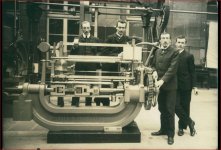JHolland:
The picture of the Riehle Brothers testing machine brings back memories of my time at Brooklyn Technical HS in the mid -late 60's. In our junior year, we took a basic strength of materials course, and it included learning about bending moments, figuring simple structural steel, and included a lab. The lab consisted of experiments to plot the stress-strain curves on different materials when doing tensile tests and derive the Modulus of Elasticity, and it included concrete cylinder tests, "dogbone" tensile tests of mortar speciments, torsion tests, Charpy impact tests, and tensile tests on sample riveted connections. We kids used a variety of testing machines, one of which was a Riehle tensile tester much like the one in the photo. We were testing samples of sheet metals (steel, brass, bronze, copper). Three of us at a time were assigned to the Riehle testing machine while other kids were off doing other tests. Our teacher had us run the Riehle testing machine by hand, so a kid named Joe Granato cranked the main drive to the screws, applying the load. I cranked the handwheel to run the "counterpoise weight" out on the balance beam, and a third kid (whose name escapes me after about 50 years) took the readings. He read an "Ames Gauge" (dial indicator) to get the "stretch" and I hollered out the counterpoise reading. Our teacher, Mr. Durso, came over and remarked we were one of the few groups to keep the balance weight beam floating, not bouncing between its stops. The Riehle machine was a well made machine with finely finished parts, but then, all the testing machines in the lab were. We had a Louis Schopper, pre-war mechanical universal testing machine with huge lead screws- made in Leipzig, Germany, in the 20's. We had a Baldwin-Southwark univeral testing machine using hydraulics, along with a mess of other testing machines. We used the Riehle tensile tester for pulling tests on those "dogbone" mortar specimens as well.
If I had to describe that strength of materials course, I would not have a good enough adjective or combination of words. I learned so much in so short a time. The first tensile test on an ASTM "505 specimen" ( 0.505" diameter at the test area, which computes to 0.400 square inches- in the pre calculator days, this was a time saver) was like a light bulb went off in my head. Between Mr. Durso's teaching and the seeing and deriving associated with that tensile test, I learned Hooke's Law, and so much more.
Unfortunately, Brooklyn Technical HS has been watered down to the point that other than the building and name, little remains of what it was when I was there. I call it being "de nutted". I have no doubt the modern "educators" and "kinder, gentler" types have ripped out the old strength of materials lab equipment. I know there is one testing lab on the East Coast of the USA still using a Riehle testing machine that is well over 100 years old. I can also say that the education I got at Brooklyn Tech, hands-on as well as in the classrooms, was superior to what I got in undergraduate engineering school, and reached me in a way that no computer simulation or modern teaching methods ever could. I've used what I learned, particularly in that basic strength of materials course, over my entire career. People ask me how I can whip through structural calculations or figure the "stretch" on studbolts and what the clamping force will be and I tell them: "I learned it in high school, not in college". I learned the bulk of it in a few semesters at 'Tech.




